Report on Energy Demand, Supply, and Renewable Energy in the US
VerifiedAdded on 2021/04/19
|8
|1482
|39
Report
AI Summary
This report provides a comprehensive analysis of the energy demand and supply dynamics in the United States. It examines the relationship between population growth and energy demand, highlighting the increasing consumption of electricity and its impact. The report details the primary energy sources, including natural gas, petroleum, coal, and renewable energy, and analyzes the trends in energy production and consumption. It also explores the growing contribution of renewable energy sources like biomass and hydroelectric power, and their increasing usage across various sectors, particularly the transportation sector. The analysis also addresses the country's shift towards energy self-sufficiency and the role of natural gas in meeting domestic demand. The report concludes by summarizing the key findings and emphasizing the importance of renewable energy in the US energy landscape.

Running Head: DEMAND AND SUPPLY OF ENERGY IN UNITED STATE
Demand And Supply of Energy in United State
Name of the Student
Name of the University
Author note
Demand And Supply of Energy in United State
Name of the Student
Name of the University
Author note
Paraphrase This Document
Need a fresh take? Get an instant paraphrase of this document with our AI Paraphraser

1DEMAND AND SUPPLY OF ENERGY IN UNITED STATE
Abstract
The paper aims to study the scenario of demand and supply in United State.US is one of the
fastest growing nation in the world. The energy demand is growing at a faster rate than
population growth. The three central question that the paper addresses are relation between
population growth and energy demand, comparison between demand and supply and finally
usage of renewable energy sources.
Abstract
The paper aims to study the scenario of demand and supply in United State.US is one of the
fastest growing nation in the world. The energy demand is growing at a faster rate than
population growth. The three central question that the paper addresses are relation between
population growth and energy demand, comparison between demand and supply and finally
usage of renewable energy sources.
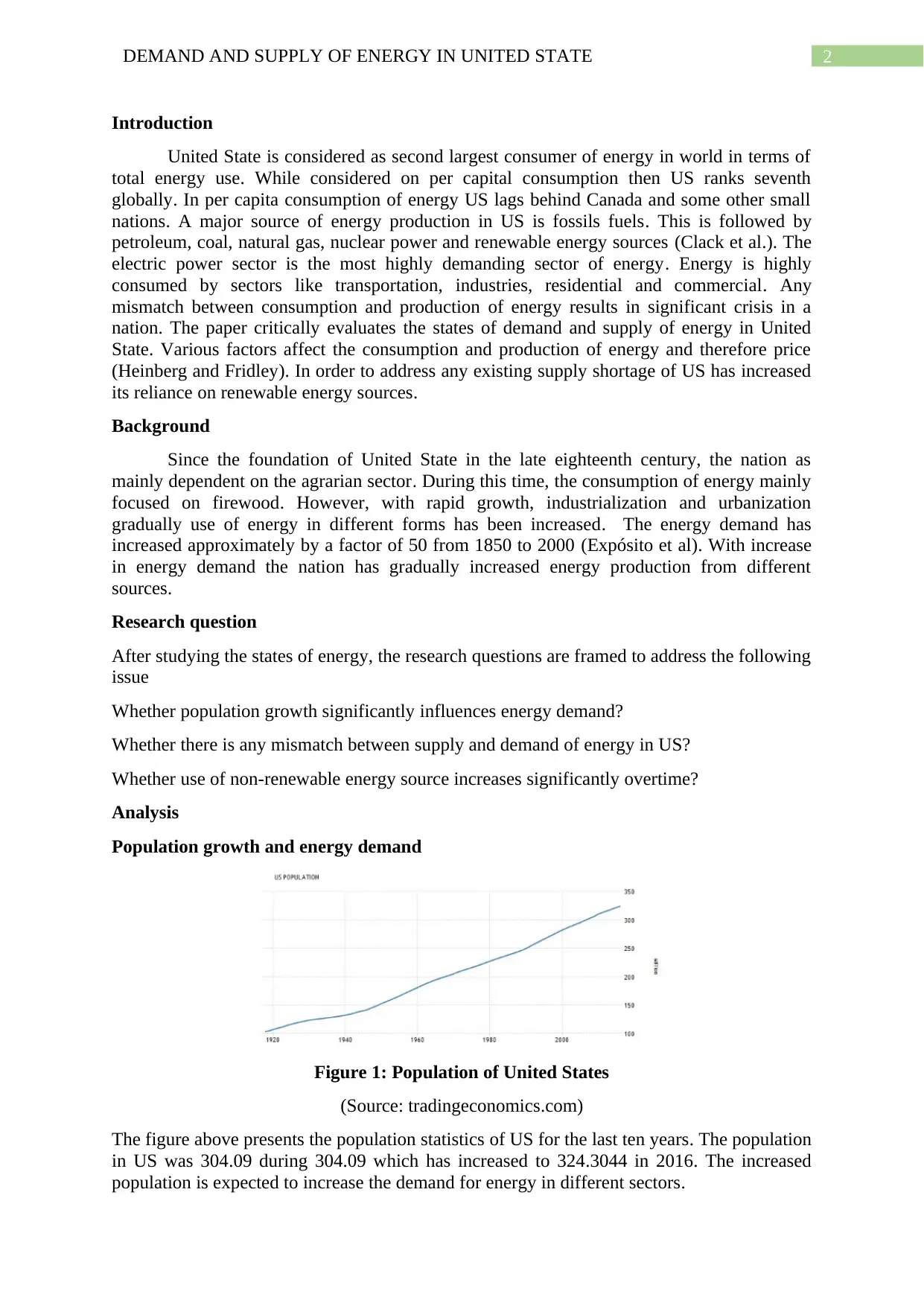
2DEMAND AND SUPPLY OF ENERGY IN UNITED STATE
Introduction
United State is considered as second largest consumer of energy in world in terms of
total energy use. While considered on per capital consumption then US ranks seventh
globally. In per capita consumption of energy US lags behind Canada and some other small
nations. A major source of energy production in US is fossils fuels. This is followed by
petroleum, coal, natural gas, nuclear power and renewable energy sources (Clack et al.). The
electric power sector is the most highly demanding sector of energy. Energy is highly
consumed by sectors like transportation, industries, residential and commercial. Any
mismatch between consumption and production of energy results in significant crisis in a
nation. The paper critically evaluates the states of demand and supply of energy in United
State. Various factors affect the consumption and production of energy and therefore price
(Heinberg and Fridley). In order to address any existing supply shortage of US has increased
its reliance on renewable energy sources.
Background
Since the foundation of United State in the late eighteenth century, the nation as
mainly dependent on the agrarian sector. During this time, the consumption of energy mainly
focused on firewood. However, with rapid growth, industrialization and urbanization
gradually use of energy in different forms has been increased. The energy demand has
increased approximately by a factor of 50 from 1850 to 2000 (Expósito et al). With increase
in energy demand the nation has gradually increased energy production from different
sources.
Research question
After studying the states of energy, the research questions are framed to address the following
issue
Whether population growth significantly influences energy demand?
Whether there is any mismatch between supply and demand of energy in US?
Whether use of non-renewable energy source increases significantly overtime?
Analysis
Population growth and energy demand
Figure 1: Population of United States
(Source: tradingeconomics.com)
The figure above presents the population statistics of US for the last ten years. The population
in US was 304.09 during 304.09 which has increased to 324.3044 in 2016. The increased
population is expected to increase the demand for energy in different sectors.
Introduction
United State is considered as second largest consumer of energy in world in terms of
total energy use. While considered on per capital consumption then US ranks seventh
globally. In per capita consumption of energy US lags behind Canada and some other small
nations. A major source of energy production in US is fossils fuels. This is followed by
petroleum, coal, natural gas, nuclear power and renewable energy sources (Clack et al.). The
electric power sector is the most highly demanding sector of energy. Energy is highly
consumed by sectors like transportation, industries, residential and commercial. Any
mismatch between consumption and production of energy results in significant crisis in a
nation. The paper critically evaluates the states of demand and supply of energy in United
State. Various factors affect the consumption and production of energy and therefore price
(Heinberg and Fridley). In order to address any existing supply shortage of US has increased
its reliance on renewable energy sources.
Background
Since the foundation of United State in the late eighteenth century, the nation as
mainly dependent on the agrarian sector. During this time, the consumption of energy mainly
focused on firewood. However, with rapid growth, industrialization and urbanization
gradually use of energy in different forms has been increased. The energy demand has
increased approximately by a factor of 50 from 1850 to 2000 (Expósito et al). With increase
in energy demand the nation has gradually increased energy production from different
sources.
Research question
After studying the states of energy, the research questions are framed to address the following
issue
Whether population growth significantly influences energy demand?
Whether there is any mismatch between supply and demand of energy in US?
Whether use of non-renewable energy source increases significantly overtime?
Analysis
Population growth and energy demand
Figure 1: Population of United States
(Source: tradingeconomics.com)
The figure above presents the population statistics of US for the last ten years. The population
in US was 304.09 during 304.09 which has increased to 324.3044 in 2016. The increased
population is expected to increase the demand for energy in different sectors.
⊘ This is a preview!⊘
Do you want full access?
Subscribe today to unlock all pages.

Trusted by 1+ million students worldwide
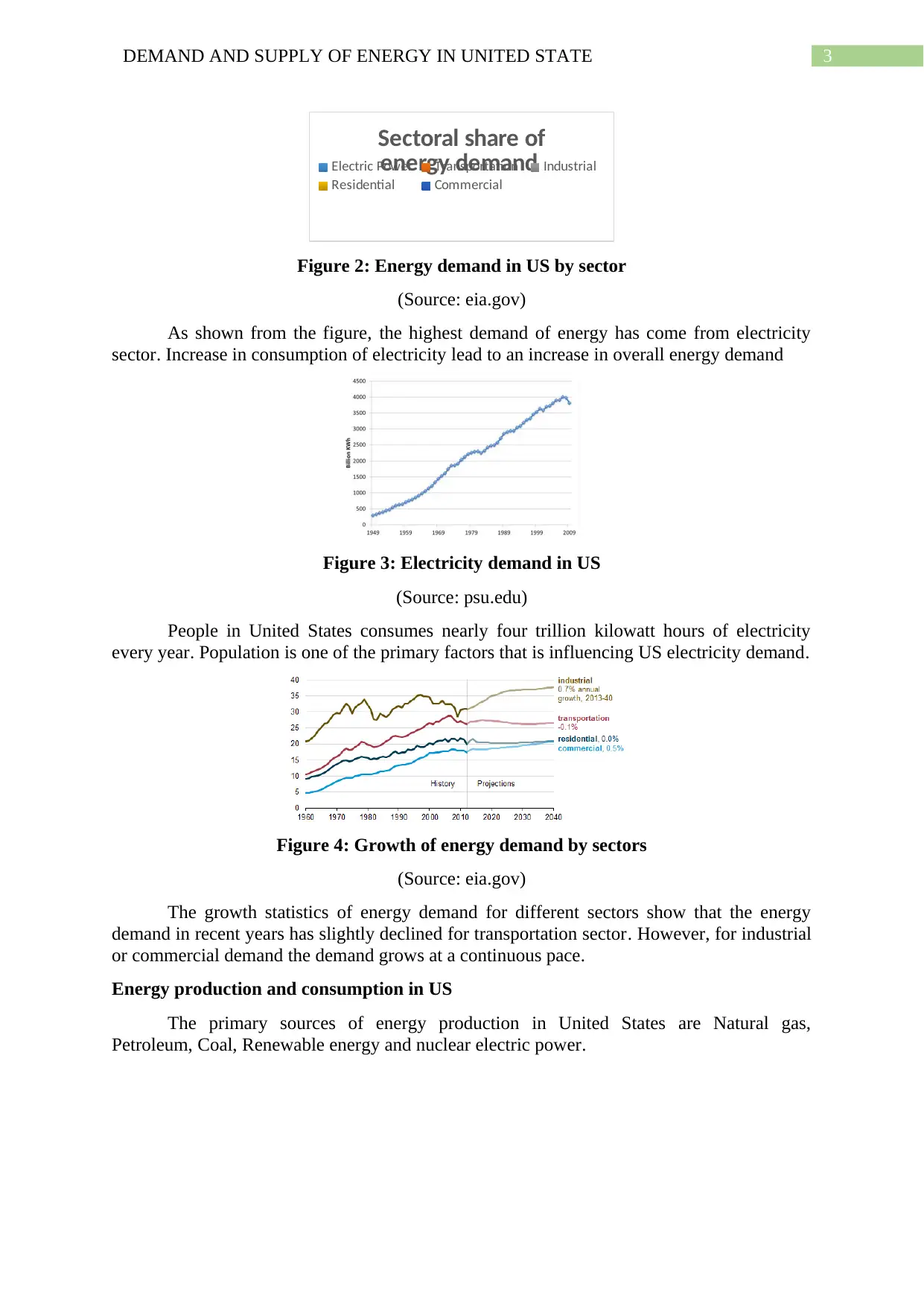
3DEMAND AND SUPPLY OF ENERGY IN UNITED STATE
Sectoral share of
energy demandElectric Power Transportation Industrial
Residential Commercial
Figure 2: Energy demand in US by sector
(Source: eia.gov)
As shown from the figure, the highest demand of energy has come from electricity
sector. Increase in consumption of electricity lead to an increase in overall energy demand
Figure 3: Electricity demand in US
(Source: psu.edu)
People in United States consumes nearly four trillion kilowatt hours of electricity
every year. Population is one of the primary factors that is influencing US electricity demand.
Figure 4: Growth of energy demand by sectors
(Source: eia.gov)
The growth statistics of energy demand for different sectors show that the energy
demand in recent years has slightly declined for transportation sector. However, for industrial
or commercial demand the demand grows at a continuous pace.
Energy production and consumption in US
The primary sources of energy production in United States are Natural gas,
Petroleum, Coal, Renewable energy and nuclear electric power.
Sectoral share of
energy demandElectric Power Transportation Industrial
Residential Commercial
Figure 2: Energy demand in US by sector
(Source: eia.gov)
As shown from the figure, the highest demand of energy has come from electricity
sector. Increase in consumption of electricity lead to an increase in overall energy demand
Figure 3: Electricity demand in US
(Source: psu.edu)
People in United States consumes nearly four trillion kilowatt hours of electricity
every year. Population is one of the primary factors that is influencing US electricity demand.
Figure 4: Growth of energy demand by sectors
(Source: eia.gov)
The growth statistics of energy demand for different sectors show that the energy
demand in recent years has slightly declined for transportation sector. However, for industrial
or commercial demand the demand grows at a continuous pace.
Energy production and consumption in US
The primary sources of energy production in United States are Natural gas,
Petroleum, Coal, Renewable energy and nuclear electric power.
Paraphrase This Document
Need a fresh take? Get an instant paraphrase of this document with our AI Paraphraser
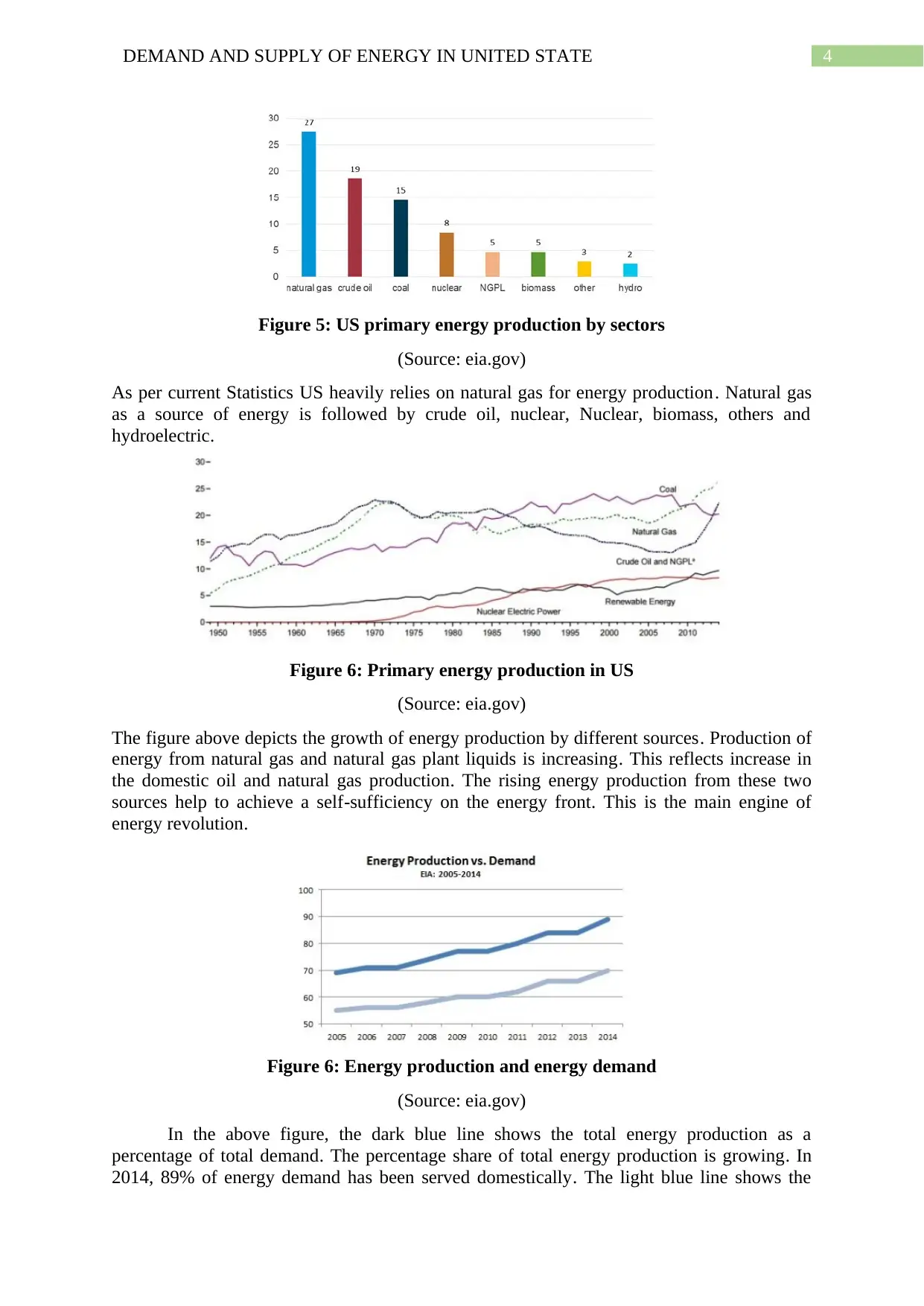
4DEMAND AND SUPPLY OF ENERGY IN UNITED STATE
Figure 5: US primary energy production by sectors
(Source: eia.gov)
As per current Statistics US heavily relies on natural gas for energy production. Natural gas
as a source of energy is followed by crude oil, nuclear, Nuclear, biomass, others and
hydroelectric.
Figure 6: Primary energy production in US
(Source: eia.gov)
The figure above depicts the growth of energy production by different sources. Production of
energy from natural gas and natural gas plant liquids is increasing. This reflects increase in
the domestic oil and natural gas production. The rising energy production from these two
sources help to achieve a self-sufficiency on the energy front. This is the main engine of
energy revolution.
Figure 6: Energy production and energy demand
(Source: eia.gov)
In the above figure, the dark blue line shows the total energy production as a
percentage of total demand. The percentage share of total energy production is growing. In
2014, 89% of energy demand has been served domestically. The light blue line shows the
Figure 5: US primary energy production by sectors
(Source: eia.gov)
As per current Statistics US heavily relies on natural gas for energy production. Natural gas
as a source of energy is followed by crude oil, nuclear, Nuclear, biomass, others and
hydroelectric.
Figure 6: Primary energy production in US
(Source: eia.gov)
The figure above depicts the growth of energy production by different sources. Production of
energy from natural gas and natural gas plant liquids is increasing. This reflects increase in
the domestic oil and natural gas production. The rising energy production from these two
sources help to achieve a self-sufficiency on the energy front. This is the main engine of
energy revolution.
Figure 6: Energy production and energy demand
(Source: eia.gov)
In the above figure, the dark blue line shows the total energy production as a
percentage of total demand. The percentage share of total energy production is growing. In
2014, 89% of energy demand has been served domestically. The light blue line shows the
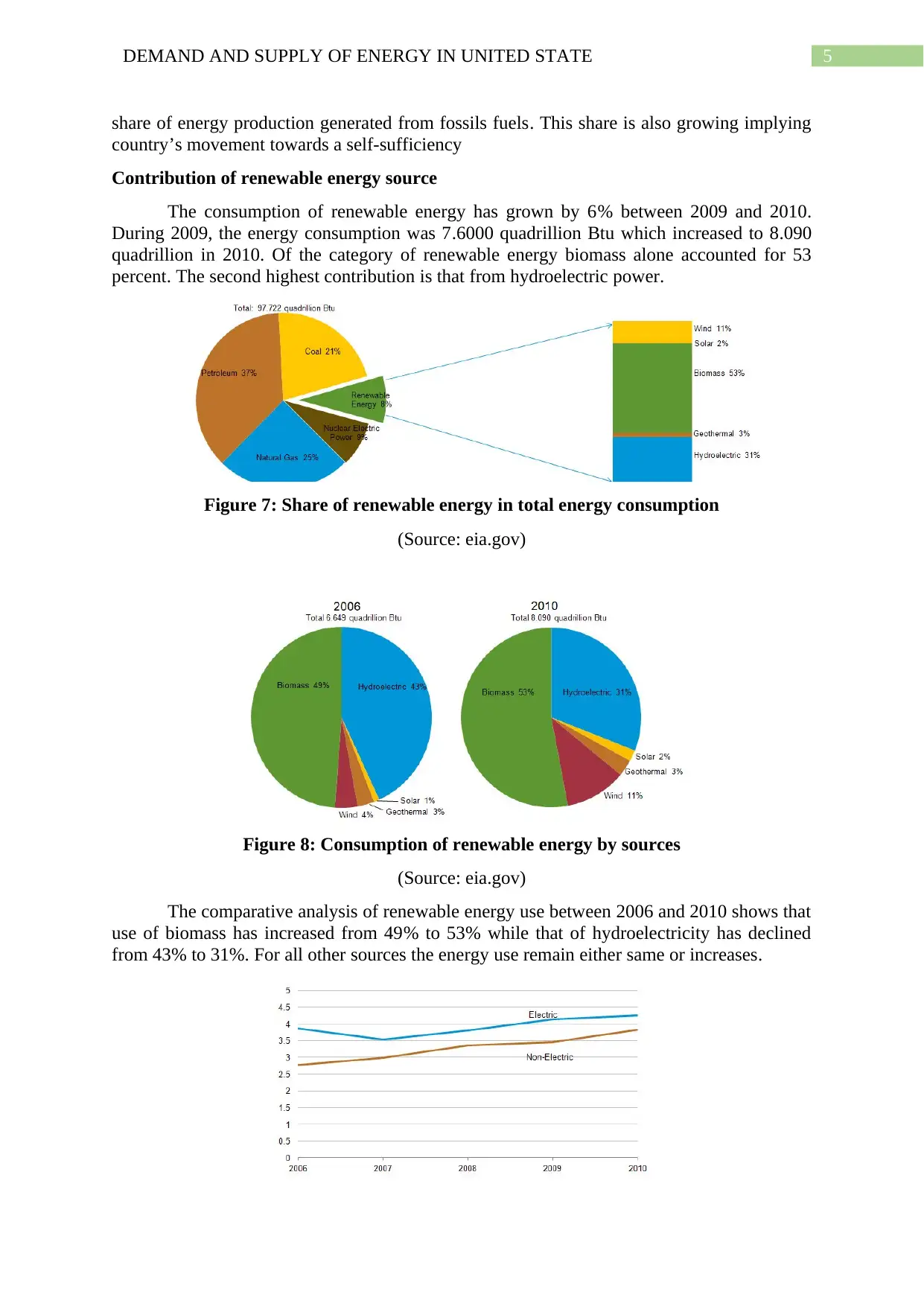
5DEMAND AND SUPPLY OF ENERGY IN UNITED STATE
share of energy production generated from fossils fuels. This share is also growing implying
country’s movement towards a self-sufficiency
Contribution of renewable energy source
The consumption of renewable energy has grown by 6% between 2009 and 2010.
During 2009, the energy consumption was 7.6000 quadrillion Btu which increased to 8.090
quadrillion in 2010. Of the category of renewable energy biomass alone accounted for 53
percent. The second highest contribution is that from hydroelectric power.
Figure 7: Share of renewable energy in total energy consumption
(Source: eia.gov)
Figure 8: Consumption of renewable energy by sources
(Source: eia.gov)
The comparative analysis of renewable energy use between 2006 and 2010 shows that
use of biomass has increased from 49% to 53% while that of hydroelectricity has declined
from 43% to 31%. For all other sources the energy use remain either same or increases.
share of energy production generated from fossils fuels. This share is also growing implying
country’s movement towards a self-sufficiency
Contribution of renewable energy source
The consumption of renewable energy has grown by 6% between 2009 and 2010.
During 2009, the energy consumption was 7.6000 quadrillion Btu which increased to 8.090
quadrillion in 2010. Of the category of renewable energy biomass alone accounted for 53
percent. The second highest contribution is that from hydroelectric power.
Figure 7: Share of renewable energy in total energy consumption
(Source: eia.gov)
Figure 8: Consumption of renewable energy by sources
(Source: eia.gov)
The comparative analysis of renewable energy use between 2006 and 2010 shows that
use of biomass has increased from 49% to 53% while that of hydroelectricity has declined
from 43% to 31%. For all other sources the energy use remain either same or increases.
⊘ This is a preview!⊘
Do you want full access?
Subscribe today to unlock all pages.

Trusted by 1+ million students worldwide
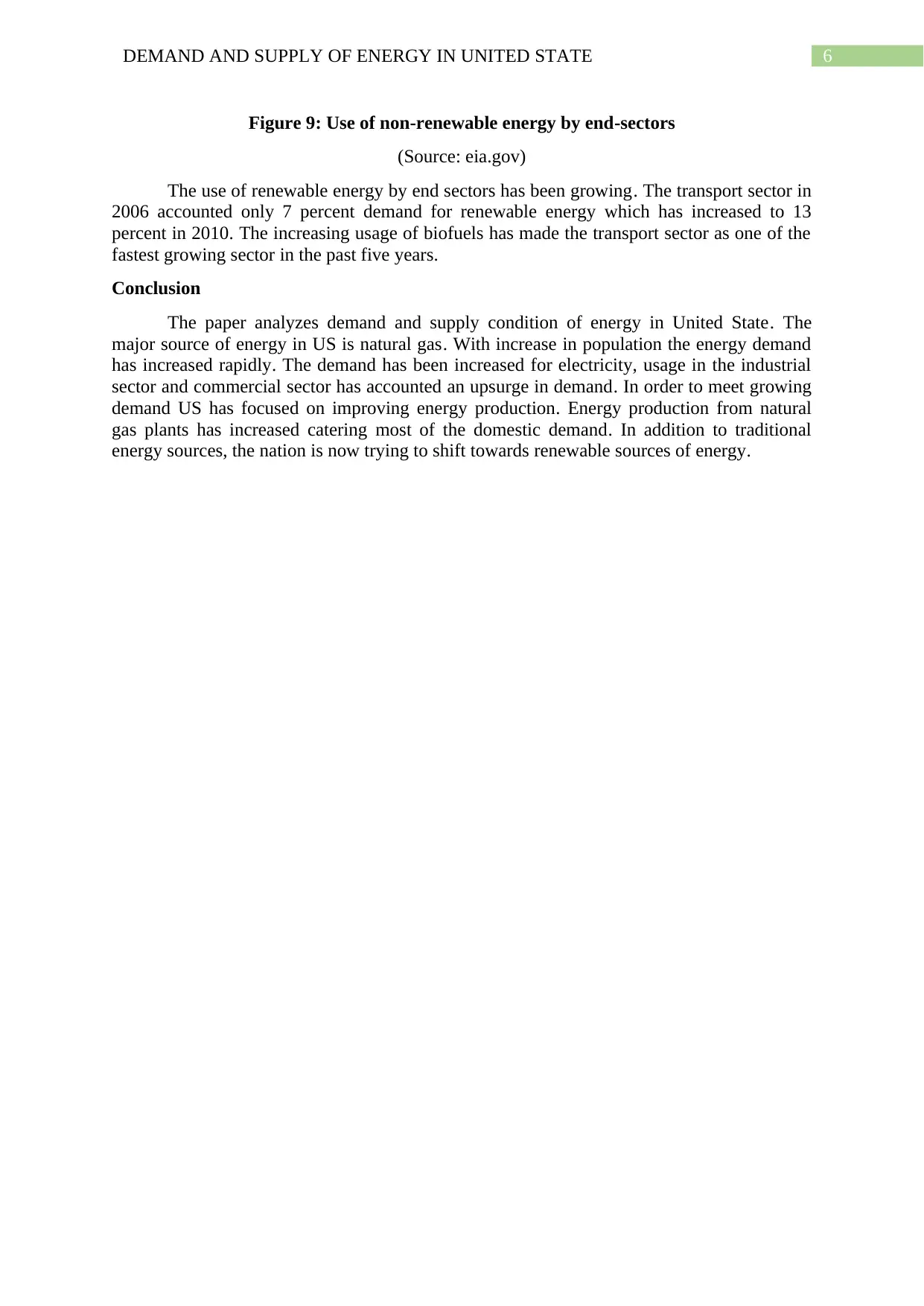
6DEMAND AND SUPPLY OF ENERGY IN UNITED STATE
Figure 9: Use of non-renewable energy by end-sectors
(Source: eia.gov)
The use of renewable energy by end sectors has been growing. The transport sector in
2006 accounted only 7 percent demand for renewable energy which has increased to 13
percent in 2010. The increasing usage of biofuels has made the transport sector as one of the
fastest growing sector in the past five years.
Conclusion
The paper analyzes demand and supply condition of energy in United State. The
major source of energy in US is natural gas. With increase in population the energy demand
has increased rapidly. The demand has been increased for electricity, usage in the industrial
sector and commercial sector has accounted an upsurge in demand. In order to meet growing
demand US has focused on improving energy production. Energy production from natural
gas plants has increased catering most of the domestic demand. In addition to traditional
energy sources, the nation is now trying to shift towards renewable sources of energy.
Figure 9: Use of non-renewable energy by end-sectors
(Source: eia.gov)
The use of renewable energy by end sectors has been growing. The transport sector in
2006 accounted only 7 percent demand for renewable energy which has increased to 13
percent in 2010. The increasing usage of biofuels has made the transport sector as one of the
fastest growing sector in the past five years.
Conclusion
The paper analyzes demand and supply condition of energy in United State. The
major source of energy in US is natural gas. With increase in population the energy demand
has increased rapidly. The demand has been increased for electricity, usage in the industrial
sector and commercial sector has accounted an upsurge in demand. In order to meet growing
demand US has focused on improving energy production. Energy production from natural
gas plants has increased catering most of the domestic demand. In addition to traditional
energy sources, the nation is now trying to shift towards renewable sources of energy.
Paraphrase This Document
Need a fresh take? Get an instant paraphrase of this document with our AI Paraphraser
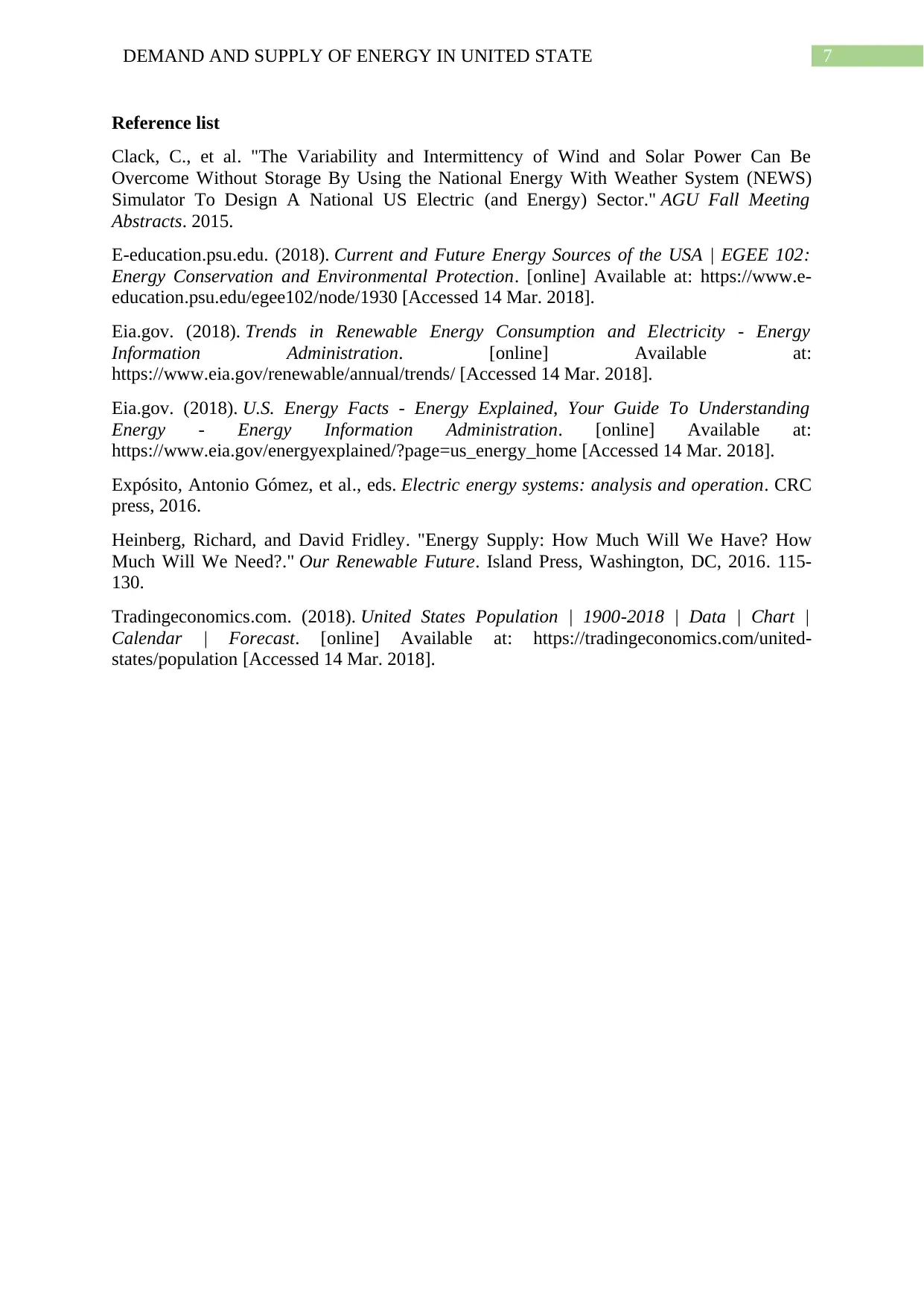
7DEMAND AND SUPPLY OF ENERGY IN UNITED STATE
Reference list
Clack, C., et al. "The Variability and Intermittency of Wind and Solar Power Can Be
Overcome Without Storage By Using the National Energy With Weather System (NEWS)
Simulator To Design A National US Electric (and Energy) Sector." AGU Fall Meeting
Abstracts. 2015.
E-education.psu.edu. (2018). Current and Future Energy Sources of the USA | EGEE 102:
Energy Conservation and Environmental Protection. [online] Available at: https://www.e-
education.psu.edu/egee102/node/1930 [Accessed 14 Mar. 2018].
Eia.gov. (2018). Trends in Renewable Energy Consumption and Electricity - Energy
Information Administration. [online] Available at:
https://www.eia.gov/renewable/annual/trends/ [Accessed 14 Mar. 2018].
Eia.gov. (2018). U.S. Energy Facts - Energy Explained, Your Guide To Understanding
Energy - Energy Information Administration. [online] Available at:
https://www.eia.gov/energyexplained/?page=us_energy_home [Accessed 14 Mar. 2018].
Expósito, Antonio Gómez, et al., eds. Electric energy systems: analysis and operation. CRC
press, 2016.
Heinberg, Richard, and David Fridley. "Energy Supply: How Much Will We Have? How
Much Will We Need?." Our Renewable Future. Island Press, Washington, DC, 2016. 115-
130.
Tradingeconomics.com. (2018). United States Population | 1900-2018 | Data | Chart |
Calendar | Forecast. [online] Available at: https://tradingeconomics.com/united-
states/population [Accessed 14 Mar. 2018].
Reference list
Clack, C., et al. "The Variability and Intermittency of Wind and Solar Power Can Be
Overcome Without Storage By Using the National Energy With Weather System (NEWS)
Simulator To Design A National US Electric (and Energy) Sector." AGU Fall Meeting
Abstracts. 2015.
E-education.psu.edu. (2018). Current and Future Energy Sources of the USA | EGEE 102:
Energy Conservation and Environmental Protection. [online] Available at: https://www.e-
education.psu.edu/egee102/node/1930 [Accessed 14 Mar. 2018].
Eia.gov. (2018). Trends in Renewable Energy Consumption and Electricity - Energy
Information Administration. [online] Available at:
https://www.eia.gov/renewable/annual/trends/ [Accessed 14 Mar. 2018].
Eia.gov. (2018). U.S. Energy Facts - Energy Explained, Your Guide To Understanding
Energy - Energy Information Administration. [online] Available at:
https://www.eia.gov/energyexplained/?page=us_energy_home [Accessed 14 Mar. 2018].
Expósito, Antonio Gómez, et al., eds. Electric energy systems: analysis and operation. CRC
press, 2016.
Heinberg, Richard, and David Fridley. "Energy Supply: How Much Will We Have? How
Much Will We Need?." Our Renewable Future. Island Press, Washington, DC, 2016. 115-
130.
Tradingeconomics.com. (2018). United States Population | 1900-2018 | Data | Chart |
Calendar | Forecast. [online] Available at: https://tradingeconomics.com/united-
states/population [Accessed 14 Mar. 2018].
1 out of 8
Related Documents
Your All-in-One AI-Powered Toolkit for Academic Success.
+13062052269
info@desklib.com
Available 24*7 on WhatsApp / Email
![[object Object]](/_next/static/media/star-bottom.7253800d.svg)
Unlock your academic potential
Copyright © 2020–2025 A2Z Services. All Rights Reserved. Developed and managed by ZUCOL.





